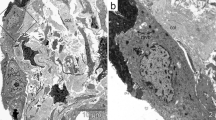Abstract
Epithelial remodeling probably contributes to parenchymal deterioration in usual interstitial pneumonia/idiopathic pulmonary fibrosis (UIP/IPF), but understanding its mechanisms is still a challenge. The aim of our study was to examine apoptosis and the epithelial changes in the histologic pattern of UIP. After immunohistochemical staining we quantified the content of type I cells, type II cells, surfactant-A protein, bcl-2, and Fas-ligand (Fas-L) in control and alveolar collapse, fibroblastic foci, and honeycomb in UIP areas of 23 open lung biopsies. A significant association was found between epithelial changes and parenchymal deterioration (p < 0.05). Type I epithelial cell density was similar between control (1.7 ± 0.7%) and UIP alveolar collapse areas (1.8 ± 0.6%) but decreased progressively in fibroblastic foci zones (0.8 ± 0.4%) and honeycomb changes (0.4 ± 0.3%). Type II cell density increased from control (25.6 ± 8.3%) to areas of alveolar collapse (34.5 ± 11.4%), then decreased toward fibroblastic foci (15.4 ± 6.0%) and honeycomb change areas (23.1 ± 8.6%). The surfactant-A protein increased from control (6.7 ± 3.2%) to areas of alveolar collapse (31.1 ± 9.5%) and decreased toward fibroblastic foci (14.5 ± 4.9%) and honeycomb change areas (21.1 ± 8.9%). Fas-L positive epithelial cell density presented a progressive decline from control (48.5 ± 9.5%), alveolar collapse (37.9 ± 12.4%), fibroblastic foci (27.4 ± 6.8%), and honeycomb change areas (21.9 ± 6.5%). A similar decline in density was found for bcl-2 positive epithelial cells from control (20.4 ± 2.7%), alveolar collapse (18.9 ± 5.1%), and fibroblastic foci areas (13.8 ±2.9%), then increased honeycomb change areas (16.3 ± 2.8%). We conclude that loss of the nuclear (bcl-2) and membrane (Fas-L) regulation of normal cell population density and suppression of cell death by apoptosis in UIP may be a determinant of the abnormal epithelial/parenchymal remodeling in UIP.

Similar content being viewed by others
References
American Thoracic Society / European Respiratory Society (2002) International Multidisciplinary Consensus Classification of the Idiopathic Interstitial Pneumonias. Am J Respir Crit Care Med 165:277–304
Bachofen H, Gehr P, Weibel ER (1979) Alterations of mechanical properties and morphology in excised rabbit lungs rinsed with a detergent. J Appl Physiol 47(5):1002–1010
Barbas–Filho JV, Ferreira MA, Sesso A, et al. (2001) Evidence of type II pneumocyte apoptosis in the pathogenesis of idiopathic pulmonary fibrosis (IFP)/usual interstitial pneumonia (UIP). J Clin Pathol 54(2):132–138
Basset F, Feirans VJ, Soler P, et al. (1986) Intraluminal fibrosis in interstitial lung disorders. Am J Pathol 122:443–461
Burkhardt A (1989) Alveolitis and collapse in the pathogenesis of pulmonary fibrosis. Am Rev Respir Dis 140:513–524
Chilosi M, Poletti V, Murer B, et al. (2002) Abnormal re-epithelization and lung remodelling in idiopathic pulmonary fibrosis: the role of ΔN-p63. Lab Invest 82:1335–1345
Coxson HO, Hogg JC, Mayo JR, et al. (1997) Quantification of idiopathic pulmonary fibrosis using computed tomography and histology. Am J Respir Crit Care Med 155:1649–1656
Demedts M, Costabel U (2002) ATS/ERS International Multidisciplinary Consensus Classification of the Idiopathic Interstitial Pneumonia. Eur Respir J 19:794–796
Fukuda Y, Ferrans VJ, Schoenberger CI, Rennard SI, Crystal RG (1985) Patterns of pulmonary structural remodeling after experimental paraquat toxicity. The morphogenesis of intraalveolar fibrosis. Am J Pathol 118:452–475
Fukuda Y, Ishizaki M, Masuda Y, et al. (1982) The role of intraalveolar fibrosis in the process of pulmonary structural remodeling in patients with diffuse alveolar damage. Am J Pathol 126:171–182
Greene KE, King TE Jr, Kuroki Y (2002) Serum surfactant proteins-A and -D as biomarkers hi idiopathic pulmonary fibrosis. Eur Respir J 19:439–446
Hunter JH, Merchant RK, Hunninghake GW (1989) Alveolar epithelium inhibits interstitial cell proliferation by the production of a low molecular weight lipid soluble factor (s). Am Rev Respir Dis 139:A615
Katzenstein AL (1985) Pathogenesis of “fibrosis” in interstitial pneumonia: an electron microscopic study. Hum Pathol 16:1015–1024
Katzenstein AL, Myers JL (1998) Idiopathic pulmonary fibrosis. Clinical relevance of pathologic classification. Am J Respir Grit Care Med 157:1301–1315
Kawanann O, Ferrans VJ, Crystal RG (1982) Structure of alveolar epithelial cells in patients with fibrotic lung disorders. Lab Invest 46:39–53
King TE, Schwarz MI, Brown K, et al. (2001) Idiopathic pulmonary fibrosis—relationship between histopathological features and mortality. Am J Respir Crit Care Med 164:1025–1032
Kuhn C 3rd, Boldt K, King TE Jr, et al. (1989) An immunohistochemical study of architectural remodelling and connective tissue synthesis in pulmonary fibrosis. Am Rev Respir Dis 140:1693–1703
McCormac FX, King TE Jr, Bucher BL, Nielsen U Mason RJ (1985) Surfactant protein A predicts survival in idiopathic pulmonary fibrosis. Am J Respir Crit Care Med 152:75l–759
Myers JL, Katzenstein A-L (1986) Epithelial necrosis and alveolar collapse in the pathogenesis of usual interstitial pneumonia. Chest 94:1309–1311
Nakajima H, Oka T (1997) Analysis of biochemical and biological functions of Fas-ligand (FasL) and Fas on activated T cells in allo-immune response. Transplant Proc 29:1096–1100
Reed JC (1998) Bcl-2 family proteins. Oncogene. 17(25):3225–3236
Selman M, King TE, Pardo A (2001) Idiopathic pulmonary fibrosis: prevailing and evolving hypotheses about its pathogenesis and implications for therapy. Ann Intern Med 134:136–151
Taylor L, Polgar P, McAteer JA, Douglas WHJ (1977) Prostaglandin production by type II alveolar cells. Biochem Biophys Acta 572:502–508
Wilson TA, Bachofen H (1982) A model for mechanical structure of the alveolar duct. J App Physiol 52:1064– 1070
Author information
Authors and Affiliations
Corresponding author
Additional information
This study was supported by the following Brazilian agencies: the National Council for Scientific and Technological Development (CNPq 300430/95-7); the Foundation for the Support of Research of the State of São Paulo (FAPESP 2000/14336-0, 2001/14566-9 and 2003/00162-9); and the Laboratories for Medical Research (LBM 05), Clinicas Hospital, School of Medicine, University of São Paulo.
Rights and permissions
About this article
Cite this article
Baptista, A.L., Parra, E.R., Filho, J.V.B. et al. Structural Features of Epithelial Remodeling in Usual Interstitial Pneumonia Histologic Pattern. Lung 184, 239–244 (2006). https://doi.org/10.1007/s00408-005-2585-9
Accepted:
Issue Date:
DOI: https://doi.org/10.1007/s00408-005-2585-9




